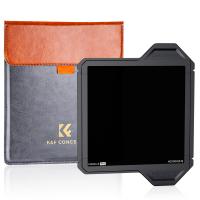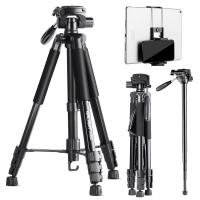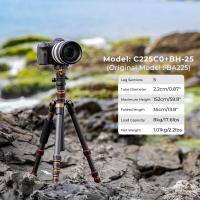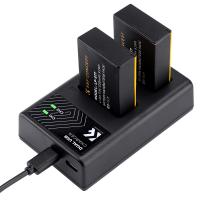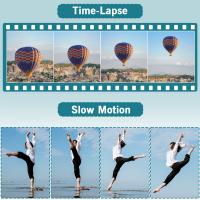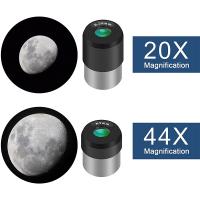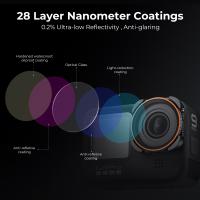When Was Digital Camera Invented ?
The first digital camera was invented in 1975 by Steven Sasson, an engineer at Eastman Kodak. However, it was not until the 1990s that digital cameras became widely available to consumers.
1、 Early history of digital cameras
When was digital camera invented?
The first digital camera was invented in 1975 by Steven Sasson, an engineer at Eastman Kodak. The camera weighed 8 pounds and had a resolution of 0.01 megapixels. It was not until the 1990s that digital cameras became commercially available and affordable for consumers. These early digital cameras had low resolutions and limited storage capacity, but they were a significant step forward in photography technology.
Since then, digital cameras have continued to evolve and improve. Today, digital cameras are ubiquitous and come in a variety of shapes and sizes, from compact point-and-shoot cameras to professional-grade DSLRs. They offer high resolutions, fast shutter speeds, and advanced features like image stabilization and face detection.
Early history of digital cameras
The development of digital cameras can be traced back to the 1960s, when NASA began using digital imaging technology to capture images of the moon during the Apollo missions. However, it was not until the 1970s that the first digital cameras were developed for commercial use.
In addition to Kodak, other companies like Sony, Canon, and Nikon began developing digital cameras in the 1980s and 1990s. These early cameras were expensive and had limited capabilities, but they paved the way for the digital cameras we use today.
The latest point of view
In recent years, the rise of smartphones has led to a decline in sales of traditional digital cameras. Many people now use their phones as their primary camera, thanks to the convenience and quality of smartphone cameras. However, professional photographers and enthusiasts still rely on digital cameras for their superior image quality and advanced features.
Overall, the invention of the digital camera has revolutionized the world of photography, making it easier and more accessible for people to capture and share their memories.

2、 First commercially available digital camera
The first commercially available digital camera was the Dycam Model 1, which was released in 1990. However, the concept of a digital camera dates back to the 1970s, when Kodak engineer Steve Sasson created a prototype that used a CCD sensor to capture and store images digitally. This early prototype was bulky and had low resolution, but it laid the groundwork for future digital cameras.
The Dycam Model 1 was a significant step forward in digital camera technology. It used a 376x240 pixel CCD sensor to capture images, which were then stored on a removable memory card. The camera was marketed primarily to journalists and other professionals who needed to quickly capture and transmit images.
Since the release of the Dycam Model 1, digital cameras have become increasingly popular and sophisticated. Today, most smartphones have built-in cameras that rival or exceed the quality of early digital cameras. Professional-grade digital cameras are capable of capturing incredibly high-resolution images and video, and they often include advanced features like interchangeable lenses and image stabilization.
Overall, the invention of the digital camera has revolutionized the way we capture and share images. It has made photography more accessible and democratized the medium, allowing anyone with a camera to become a photographer. As technology continues to advance, it will be interesting to see how digital cameras continue to evolve and shape the world of photography.

3、 Advancements in digital camera technology
When was digital camera invented?
The first digital camera was invented in 1975 by Steven Sasson, an engineer at Eastman Kodak. It was a bulky device that weighed almost 4 kg and captured black and white images with a resolution of 0.01 megapixels. However, it was a significant breakthrough in the field of photography as it marked the beginning of the digital era.
Advancements in digital camera technology
Since the invention of the first digital camera, there have been numerous advancements in digital camera technology. Today, digital cameras are smaller, lighter, and more powerful than ever before. They can capture high-resolution images and videos, and many come with advanced features such as image stabilization, face detection, and Wi-Fi connectivity.
One of the most significant advancements in digital camera technology in recent years has been the development of mirrorless cameras. These cameras do not have a mirror mechanism like traditional DSLRs, which makes them smaller and lighter. They also offer faster autofocus and continuous shooting speeds, making them ideal for sports and action photography.
Another recent development in digital camera technology is the rise of computational photography. This involves using software algorithms to enhance images and create new effects. For example, some smartphones now use computational photography to create bokeh effects, which blur the background of an image to make the subject stand out.
In conclusion, the invention of the digital camera in 1975 marked the beginning of a new era in photography. Since then, there have been numerous advancements in digital camera technology, including the development of mirrorless cameras and computational photography. These advancements have made it easier than ever for people to capture high-quality images and videos.

4、 Impact of digital cameras on photography industry
When was digital camera invented?
The first digital camera was invented in 1975 by Steven Sasson, an engineer at Eastman Kodak. However, it was not until the 1990s that digital cameras became widely available to consumers. The first consumer digital camera was the Apple QuickTake 100, released in 1994.
Impact of digital cameras on photography industry
The invention of digital cameras has had a significant impact on the photography industry. One of the most significant changes has been the shift from film to digital photography. Digital cameras allow photographers to take and store an almost unlimited number of photos, without the need for film or processing. This has made photography more accessible and affordable for both professionals and amateurs.
Digital cameras have also led to the development of new technologies, such as image stabilization, face detection, and high dynamic range (HDR) imaging. These technologies have made it easier for photographers to capture high-quality images in a variety of lighting conditions.
Another significant impact of digital cameras has been the rise of social media and online photo sharing platforms. With the ability to easily share photos online, photographers can reach a wider audience and gain more exposure for their work.
In recent years, the rise of smartphone cameras has also had an impact on the photography industry. While smartphone cameras may not offer the same level of control and quality as dedicated digital cameras, they have made photography more accessible than ever before.
Overall, the invention of digital cameras has revolutionized the photography industry, making it more accessible, affordable, and technologically advanced than ever before.
























